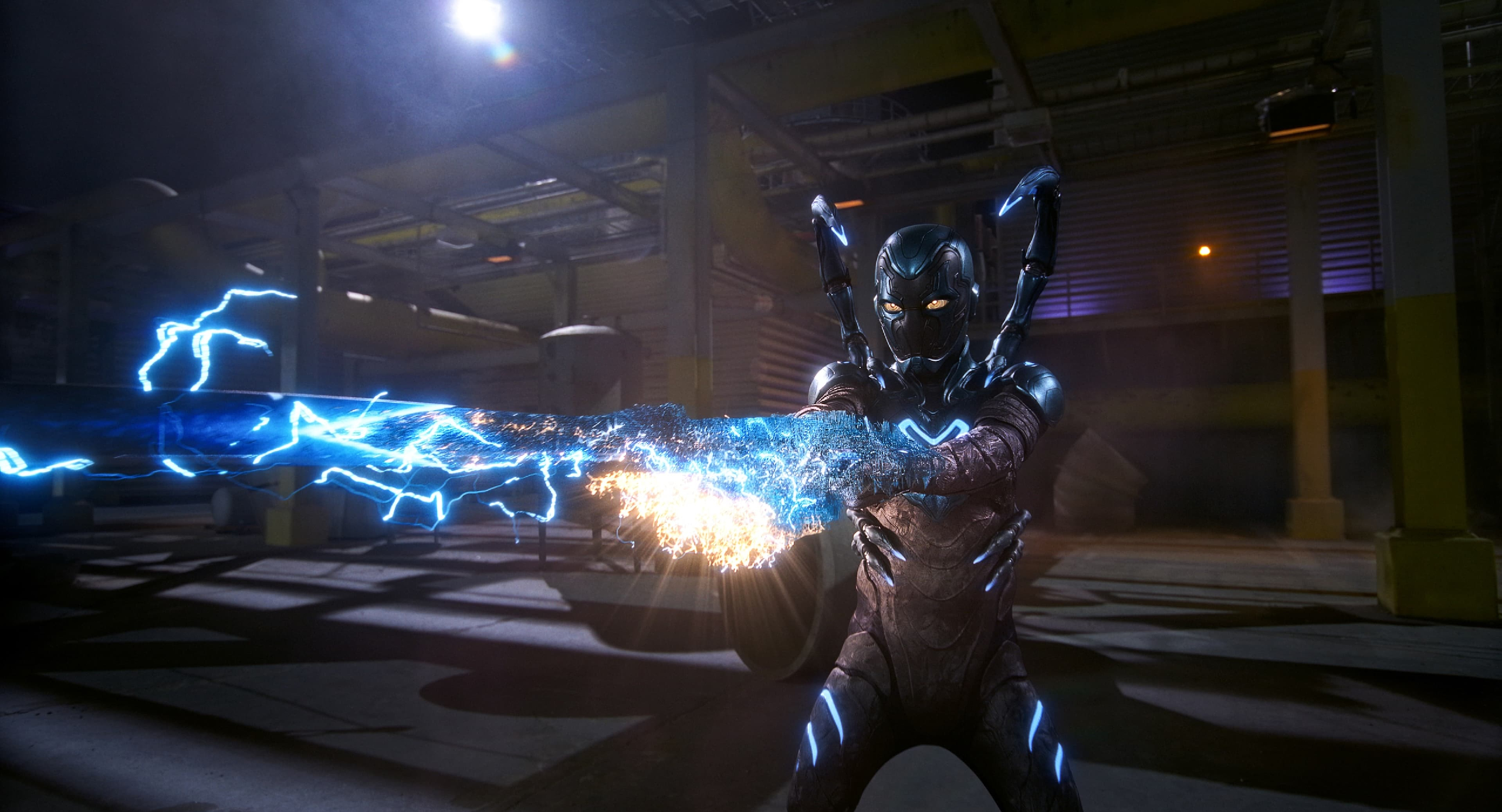Blue Beetle – Film Review
Published August 18, 2023

Jaime Reyes suddenly finds himself in possession of an ancient relic of alien biotechnology called the Scarab. When the Scarab chooses Jaime to be its symbiotic host, he’s bestowed with an incredible suit of armor that’s capable of extraordinary and unpredictable powers, forever changing his destiny as he becomes the superhero Blue Beetle.
The DC Extended Universe (DCEU) has taken audiences on a rollercoaster ride of superhero stories, from the highs of Wonder Woman to the lows of Suicide Squad. With Blue Beetle, directed by Ángel Manuel Soto, the DCEU takes a step towards diversity and a lesser-known character. This 14th installment of the DCEU introduces us to Jaime Reyes, a new face in the world of superheroes, and offers a fresh perspective on the genre. While Blue Beetle holds the promise of something new, it also struggles to break free from some of the formulaic elements that have plagued previous entries in the franchise.
The film starts off on an intriguing note, introducing us to Kord Industries’ hunt for the mysterious Scarab artifact. The film’s cold, desolate opening scenes contrast sharply with the warmth and charm of Palmera City, where Jaime Reyes (Xolo Maridueña) resides. Returning home after graduating from Gotham Law University, Jaime’s character is quickly established as someone dedicated to his family, embodying a sense of responsibility that grounds the film’s emotional core. However, as we delve deeper into the Reyes family’s financial struggles, the film sometimes veers into melodramatic territory, occasionally sacrificing nuance for emotional manipulation.
The chemistry between the cast, particularly Maridueña and Bruna Marquezine (Jenny Kord), adds a layer of authenticity to the characters’ interactions. Maridueña brings youthful energy and vulnerability to the role of Jaime Reyes, making him an easily relatable character for younger audiences. Marquezine’s portrayal of Jenny Kord adds depth to a character caught in the crossfire between family loyalty and moral responsibility. Adriana Barraza‘s portrayal of Nana, Jaime’s grandmother, brings a sense of wisdom and strength that’s sorely needed in the chaos of the film’s events.
As the story unfolds, the film’s pacing occasionally falters, especially during the exposition-heavy scenes in Kord Tower. The dialogue in these moments sometimes feels clunky, bogging down the film’s momentum. However, the film manages to regain its footing during action sequences. The arrival of the Scarab artifact and Jaime’s transformation into Blue Beetle brings a visual spectacle that’s exciting and dynamic. The Beetle Armor’s sleek design and ability to reconfigure add a unique visual flair to the film’s superhero aesthetics.
The heart of Blue Beetle lies in Jaime’s struggle to come to terms with his newfound powers and responsibilities. His internal conflict, torn between his desire for a normal life and the Scarab’s insistence on heroism, forms the emotional core of the film. The dynamic between Jaime and Khaji Da, the sentient Scarab, is a highlight, providing a source of both humor and depth. Khaji Da’s attempts to comprehend human behavior lead to some genuinely amusing moments, but it’s the exploration of the symbiotic relationship between Jaime and the Scarab that resonates the most.
Where Blue Beetle truly shines is in its exploration of cultural identity. Set in Palmera City, Texas, the film integrates Latinx culture seamlessly into its narrative. Jaime’s family dynamics, traditions, and interactions with the community contribute to a rich cultural tapestry that feels genuine and meaningful. While the film occasionally leans into clichés, such as the use of a grandmother with a machine gun, it mostly succeeds in depicting a modern Latinx family in a way that feels both fresh and authentic.
On the other hand, the film’s antagonist, Victoria Kord (Susan Sarandon), while portrayed with intensity by Sarandon, feels underdeveloped. The exploration of her motivations remains somewhat superficial, and her transition from a power-hungry businesswoman to a villain with a somewhat altruistic rationale lacks the necessary depth to make her truly compelling. The final act’s explosion-laden showdown, while visually captivating, fails to fully capitalize on the film’s character-driven potential.
In terms of visuals, the film strikes a balance between CGI-heavy action and grounded character moments. The Beetle Armor’s design, as well as the visual representation of Khaji Da, is an impressive blend of science fiction and organic aesthetics. While the action sequences are choreographed with flair, the film’s overall visual style occasionally lacks consistency, especially in the presentation of the antagonist’s lair, which feels less inspired compared to the vibrant depiction of Palmera City.
The film’s score, composed by Bobby Krlic, complements the action and emotional beats effectively, enhancing the viewing experience without overpowering the scenes. The soundtrack’s infusion of Latinx rhythms and instruments adds to the film’s cultural authenticity.
Blue Beetle offers a promising entry into the DCEU that shines a light on underrepresented voices and cultural experiences. While it stumbles in pacing and some character development areas, the film’s exploration of family, identity, and responsibility gives it a solid foundation. Xolo Maridueña’s charismatic performance and the chemistry between the cast members inject life into the film’s superhero narrative. With room for improvement in certain aspects, Blue Beetle manages to carve out a unique space within the superhero genre, signaling a potential new direction for the DCEU.
